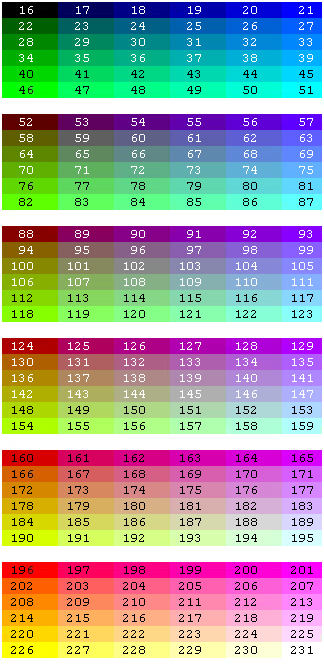Colors
16 basic colors
There are eight colors, each of which is identified by a single digit:
| 0 | black |
| 1 | red |
| 2 | green |
| 3 | yellow |
| 4 | blue |
| 5 | purple |
| 6 | cyan |
| 7 | white |
Each of these colors has a high intensity variant, which brings the number of basic colors to 16 (and correspond to the values of the .NET enum
System.ConsoleColor).
In order to create a color code, the color-digit needs to be prepended with one or two other digits (the dot represents the digit for the color):
| 3. | foreground / normal intensity |
| 4. | background / normal intensity |
| 9. | foreground / high intensity |
| 10. | background / high intensity |
Thus, for example a high intensity (=9) red (=1) text is escaped like so:
\e[91m text \e[0m
Or, … in a shell with
echo: $ echo -e "\e[91mred text\e[0m" $ echo -e "\e[103m\e[91mred text on yellow background\e[0m"
Defining the RGB values for the 16 base colors
At least in
conhost.exe, it's possible to define the RGB values for the 16 colors with \e]4;c;rgb:RR/GG/BB\x7. RR, GG and BB are the hex values for the RGB colors. c is the color number which is being defined. Note the closing bracket ].
The following PowerShell script modifies the color palette according to solarized light:
function define-color {
param (
[int] $colorNumber,
[int] $r,
[int] $g,
[int] $b
)
write-host ("$([char]27)]4;{0};rgb:{1:X2}/{2:X2}/{3:X2}$([char]7)" -f $colorNumber, $r, $g, $b)
}
define-color 0 0 39 49 // dark black
define-color 1 208 27 36 // dark red
define-color 2 114 137 5 // dark green
define-color 3 165 119 5 // dark yellow
define-color 4 32 117 199 // dark blue
define-color 5 198 27 110 // dark magenta
define-color 6 37 145 133 // dark cyan
define-color 7 233 226 203 // dark white
define-color 8 0 77 100 // bright black
define-color 9 189 54 18 // bright red
define-color 10 70 90 97 // bright green
define-color 11 82 103 111 // bright yellow
define-color 12 112 129 131 // bright blue
define-color 13 88 86 185 // bright magenta
define-color 14 129 144 143 // bright cyan
define-color 15 252 244 220 // bright white
Github repository ANSI-escape-sequences, path: /define-16-basic-colors.ps1
216 6-bit colors + 16 basic colors + 24 gray scale colors
With
\e[38;5;nm (foreground) and \e[48;5;nm (background colors), the color palette can be extended to 256 colors which are specified by n: n | |
| 0-7 | 8 colors |
| 8-15 | 8 intense color |
| 16 + 36*r + 6+g + b | RGB value (each component having 6 values) |
| 232-255 | 24 gray scale colors, black to white |
The following shell snippet prints the color with R=5, G=2 and B=0:
$ r=5
$ g=2
$ b=0
$ color=$(( 16 + $r * 36 + $g * 3 + $b ))
$ echo -e "\e[38;5;${color}mr=$r g=$g b=$b\e[0m"
Demonstration: Emit all 6-bit RGB colors with a script.
The following shell script uses the
38;5 escape function to create 216 background colors (The red, green and blue components are each in the range 0 … 5) #
# vim: ft=sh
#
ansi_color_5() {
local r=$1 # 0 .. 5
local g=$2 # 0 .. 5
local b=$3 # 0 .. 5
echo -e $(( 16+ $r*36 + $g*6 + $b))
}
ansi_color_bg_5 () {
echo -e "\e[38;5;$(ansi_color_5 $1 $2 $3)m"
}
ansi_color_fg_5 () {
echo -e "\e[48;5;$(ansi_color_5 $1 $2 $3)m"
}
ansi_reset() {
echo -e "\e[0m"
}
printf "\n"
for r in {0..5}; do
for g in {0..5}; do
for b in {0..5}; do
printf " "
if [[ $r > 3 || $g > 3 ]]; then
bg_color='0 0 0'
else
bg_color='5 5 5'
fi
printf "$(ansi_color_fg_5 $r $g $b)$(ansi_color_bg_5 $bg_color) %3d " $(ansi_color_5 $r $g $b)
done
printf $(ansi_reset)
printf "\n"
done
printf "\n"
done
Github repository ANSI-escape-sequences, path: /bg-48-fg-38-5
The output of the script is

Apparently, this python script and this Perl script do more or less the same thing.
And then, there is also the shell command
msgcat --color=test. 24-bit colors
With
\e[38;2;r;g;bm and \e[48;2;r;g;bm, The color palette is extended to true colors, r, g and b being values between 0 and 255: $ r=222 $ g=111 $ b=42 $ text="R = $r, G = $g, B = $b" $ echo -e "\e[38;2;$r;$g;$b""m$text""\e[0m"